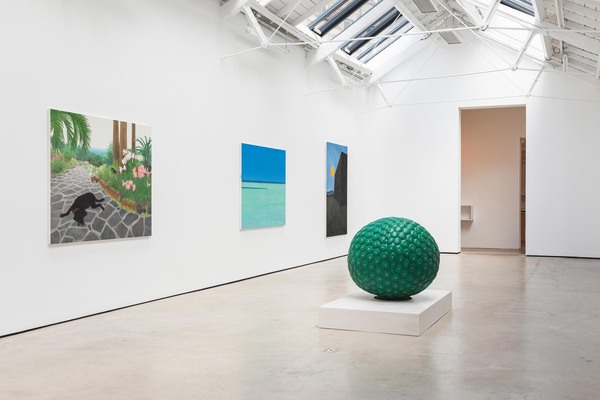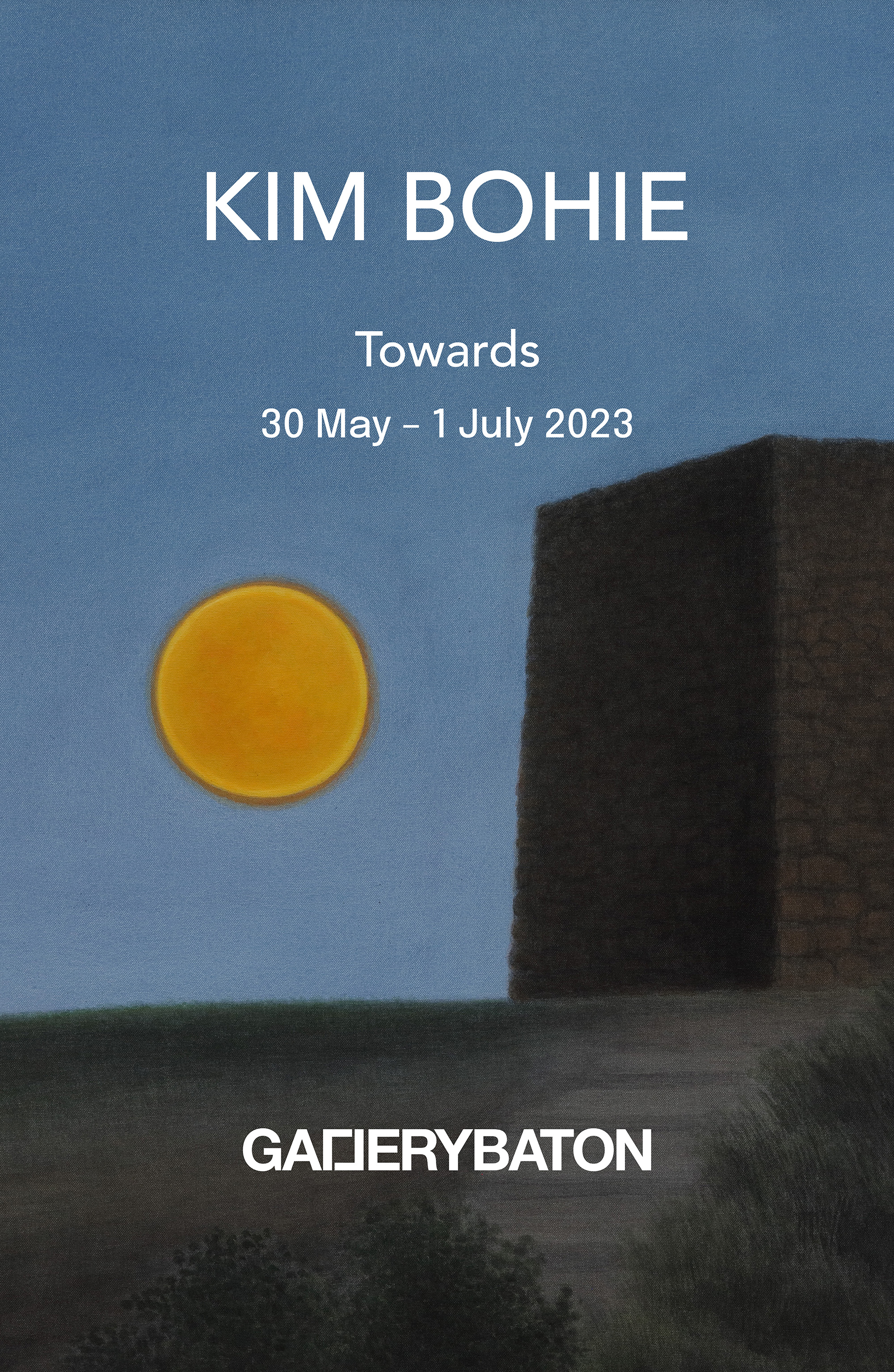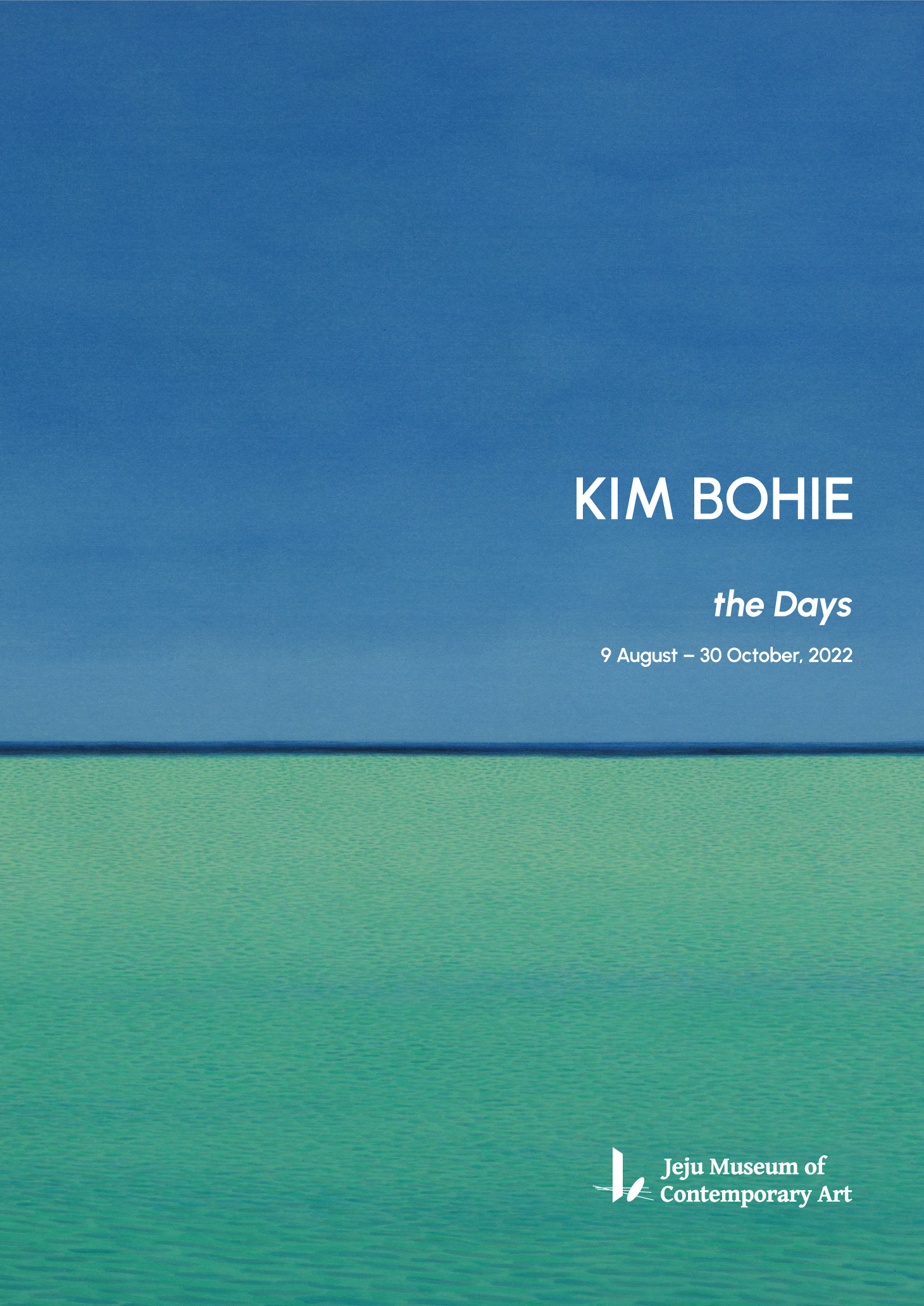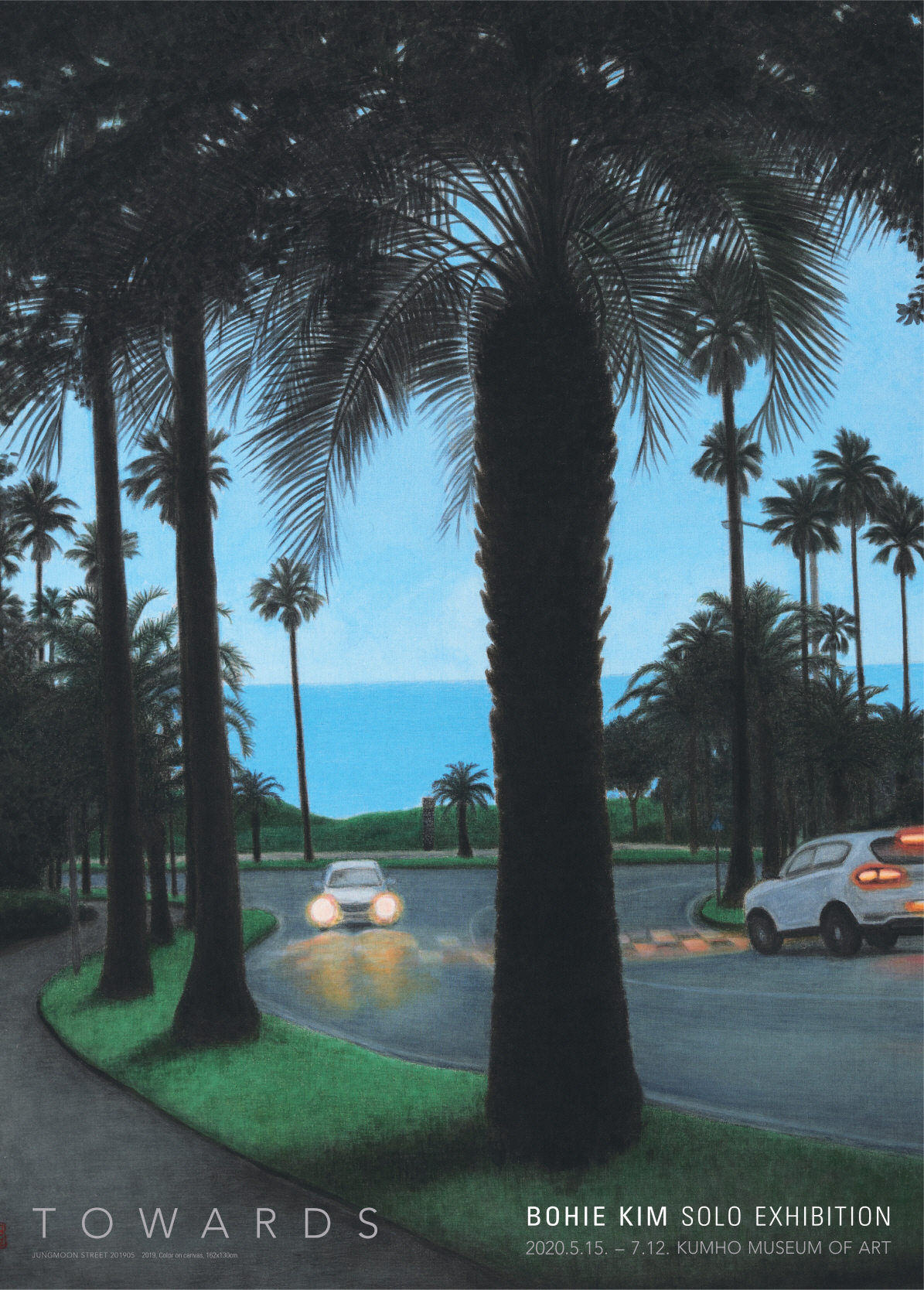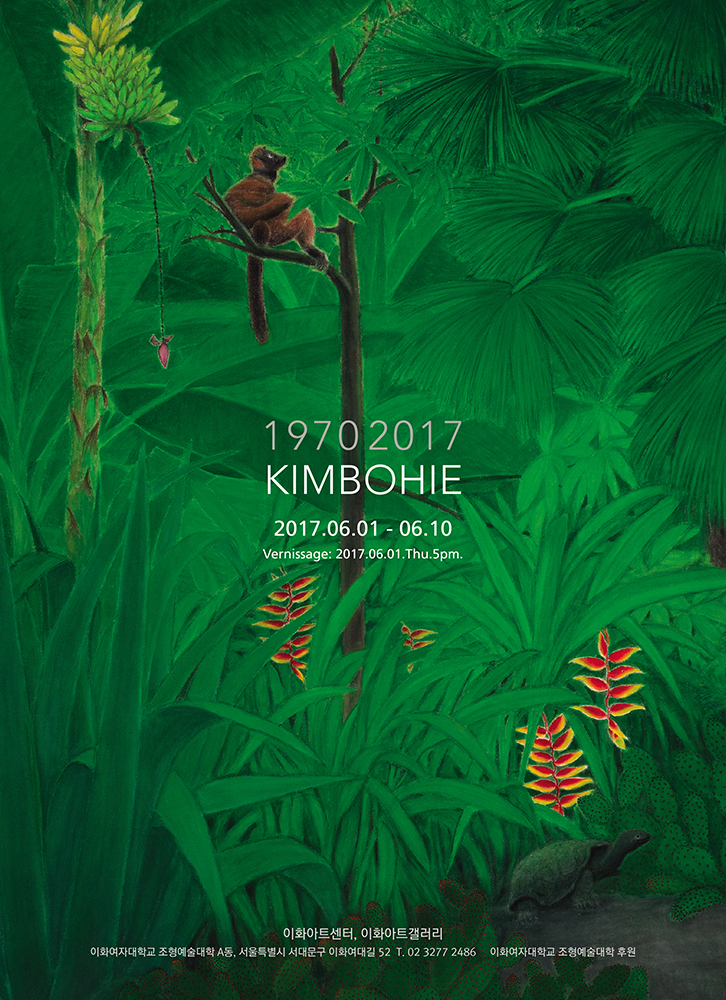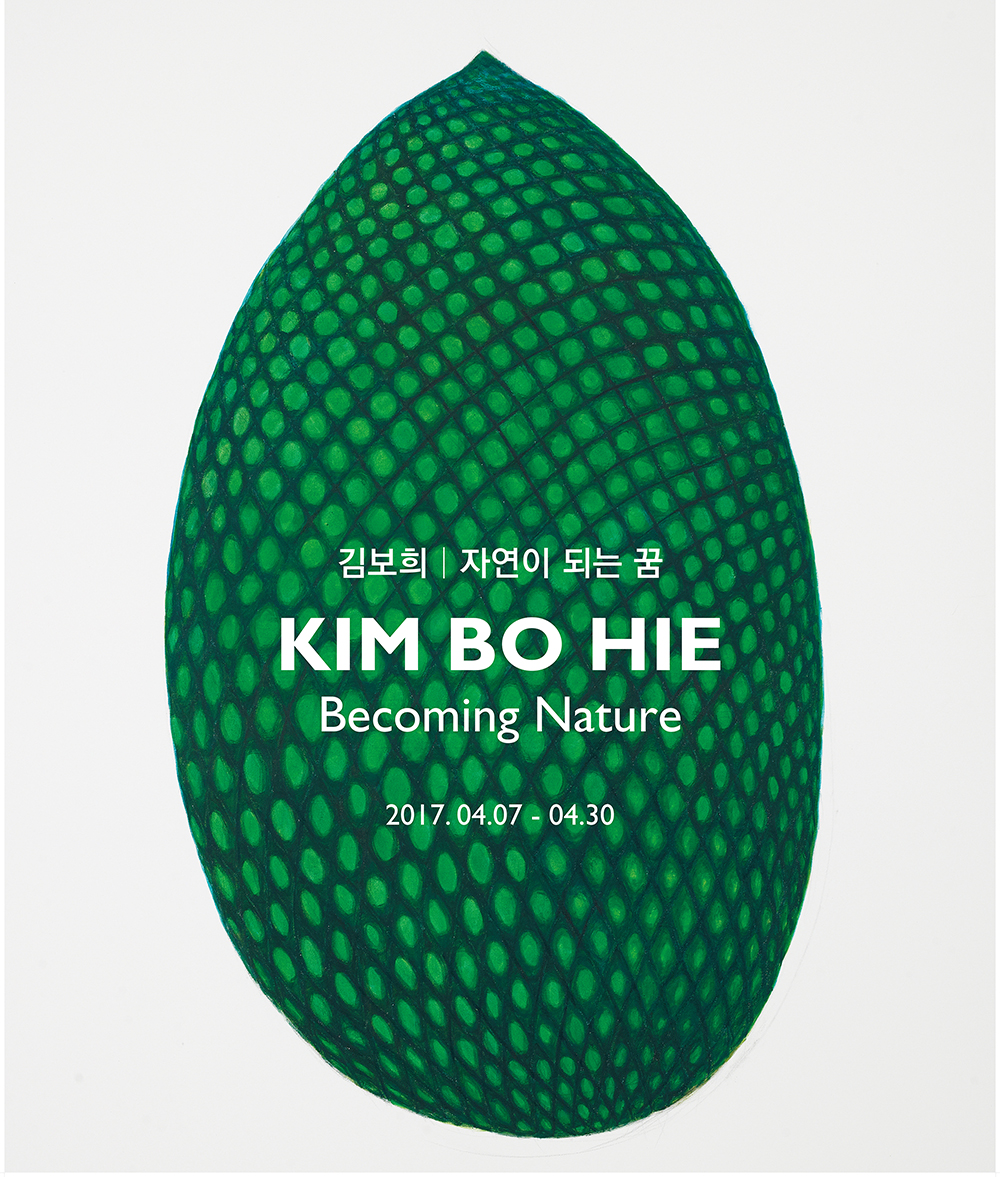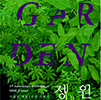PAST EXHIBITION
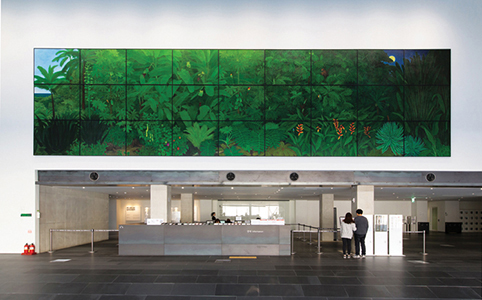
국립현대미술관 서울관 <Garden전>
2014.10.21 ~ 05.11
자연이 되는 꿈
이추영 국립현대미술관 학예연구사
울창한 열대우림의 장벽이 눈앞에 펼쳐져 있다. 키 큰 야자수, 풍성하게 매달린 바나나와 파파야, 기다란 꽃줄기가 하늘을 향해 뻗어 오른 용설란, 오밀조밀 군락을 이룬 둥근 손바닥 선인장, 수십 쌍의 잎이 대칭을 이루는 각양의 열대 식물들이 선명한 초록색으로 치장한 채 지천으로 펼쳐져있는 가히 식물의 향연이다. 각양의 식생(植生)과 동물들이 평화롭게 공존하는 이곳은 현실같이 생생한 가상의 공간이다.
인간의 시선을 가로막는 어두운 숲은 오래전에 자연을 떠난 인간이 느끼는 원초적인 두려움과 생명의 기원에 대한 본능적인 호기심이 공존하는 매혹적인 공간이다. 태초에 신이 인간에게 허락했던 파라다이스는 금단의 열매를 향한 무모한 호기심과 유혹의 결과로 인해 생명을 위협하는 공포의 공간, 싸우고 투쟁하며 먹고, 먹히는 치열한 생존의 공간으로 변해버렸다. 추운 겨울을 견디는 두터운 가죽과 털, 사냥을 위한 날카로운 발톱과 이빨, 하늘로 날아오르는 날개와 위험을 벗어나는 빠른 발은 인간 이외의 동물들에게만 허락된 축복이었다. 인류는 원초적인 약점을 극복하기 위해 끊임없이 사고하며 생존의 도구를 발명했고 어느 순간 짐승들의 그것을 능가하게 되었다. 자연과 대적(對敵)한 인간은 숲과 동굴을 벗어나 자신들의 울타리를 쌓기 시작했고 이는 거대 도시 문명의 시작이었다. 자연과 인간의 분리는 더욱 공고해졌다.
인간은 종종 자신들의 ‘문명’을 ‘자연’과 대척점에 위치시키며 미개와 원시의 영역으로 고립시킨 후, 자신들이 떠나왔던 태초의 자연을 망각하는 모습을 보여 왔다. 이는 마치 거대한 개미탑 속에 자신들의 왕국을 건설한 개미의 생태와 하등 차이점이 없는 ‘인공 생태계’에 대한 끝없는 오만함에서 비롯된 것이다. 그럼에도 여전히 인간은 지구의 작은 떨림 같은 지진과 해일, 뾰루지같이 돋아난 화산 폭발로 인해 멸망의 공포와 충격에 휩싸이는 미약한 존재일 뿐이다. 이제 막 지구 밖 세상에 눈을 뜬 인간들은 가늠할 수 없는 광활한 우주에 흩어진 먼지 같이 작은 별, 그 위에 존재하는 미약한 생명체임을 자각하지 않을 수 없다.
예술(가)은 문명의 재갈을 물고 두 눈을 가린 채 겁 없이 질주하는 인간의 무지와 한계를 비추는 존재이다. 예술(가)은 마약 같이 일시적이며 강력한 문명의 유혹에 반기를 들고 보다 영원하며 본질적인 존재를 끊임없이 갈구한다. 이들은 마치 구약 시대의 선지자처럼 문명에 구속되어 스스로 눈먼 자들을 깨우치며, 문명의 그늘에 가려진 수많은 존재들을 인식하고 이들을 새로운 시선으로 조망하도록 이끈다. 이들은 인류의 문명이 존재하기 한참 전부터 태양과 달, 수천 광년 떨어진 곳으로부터 도착한 별 빛을 흡수하며 생존해온 경이로운 존재들이다.
김보희의 시선은 인공의 빛과 소음으로 가득한 문명의 세상을 떠나 인간과 자연이 공존했던 태초의 자연, 원시적인 생명이 살아 숨 쉬던 원형으로서의 자연으로 향한다. 시공을 초월한 시선의 여행을 통해 도달한 그 곳은 현실과 환상이 한 몸을 이룬 아름다운 세계이다. 27개의 캔버스가 연결된 <그날들>의 거대한 화면은 새벽부터 밤으로 이어지는 시간의 흐름을 따라 구성되어있다. 화면의 왼쪽 상단 탁 트인 공간의 멀리 보이는 푸른 수평선은 하루를 시작을 알리는 새벽의 맑은 빛을 품고 있고, 오른쪽 위로 높이 뻗은 무성한 잎사귀에 수줍게 걸려있는 만월(滿月)은 태양의 하루를 보낸 식물들을 따뜻한 빛으로 포근히 감싸고 있다. 고요한 적막이 흐르는 숲 속의 모든 생물들은 새롭게 시작되는 하루를 위해 깊은 잠에 빠진다. 인간의 시간이 멈추고, 세상의 소음과 빛이 사라진 공간에서 자연은 비로소 온전히 숨을 쉰다.
<그날들> 속 울창한 숲의 모습은 태초에 신이 인간을 위해 창조했던, 생명의 에너지가 충만했던 원시 자연의 모습을 연상시킨다. 뾰족 튀어 나온 연두색 잎망울에서 차례로 펼쳐지며 넓게 펼쳐지는 각양의 잎들은 시원한 그늘이 되고, 앙증맞게 매달린 초록 열매들은 노랗고, 빨갛게 익어가며 생명을 살리는 과즙을 가득 품는다. 이들은 세상의 생명을 잉태한 어머니 대지의 부드럽고, 촉촉한, 따뜻한 질(膣) 속으로 깊고, 단단하게 뿌리를 내리며 생명의 수액을 한껏 뽑아 올려 가지와 잎, 열매를 통통하게 채운다. 반들반들 넓게 펴진 윤기 나는 두터운 잎은 저 멀리 우주로부터 쏟아져 내리는 태양과 달빛을 온몸으로 흡수하며 생명을 지닌 존재의 성스러운 의무를 다한다. 식물들은 갖가지 화려한 꽃을 피워 나비와 벌들을 유혹하고 조류와 동물들의 먹이가 될 열매를 만들어 씨를 퍼트리기 위해 노력한다. 생육(生育)하고 번성하는 것은 아름다운 신의 섭리이다.
가느다란 가지 위에 살포시 올라앉은 화려한 색채의 새들, 나무 둥치에 찰싹 붙어 있는 초록 도마뱀들, 커다란 잎으로 가려진 서늘한 그늘 밑에서 엉금엉금 느릿한 걸음을 옮기는 육지 거북이들, 높은 가지에 걸터앉아 편한 휴식을 취하고 있는 원숭이의 여유로운 모습에서 인간에 대한 경계와 적대감은 찾아 볼 수 없다. 이곳엔 뜨거운 태양과 폭우, 거센 바람, 인간을 해치는 독충과 독사, 맹수의 위협은 존재하지 않는다. 연약한 피부를 지닌 발가벗은 인간마저 포근히 안아줄듯 부드럽고 따뜻한 기운으로 충만한 생명의 경이로 가득 찬 세상이다. 향긋하고 신선한 과일향이 코끝을 간질이고, 아름다운 깃털을 지닌 새들의 행복한 지저귐이 귓가에 들려온다. 세상의 시간이 멈춘 이곳엔 빛의 시간으로 가득 차 있다. 어두움은 밝음을 향해 밝음은 어두음을 향해 천천히, 끊임없이 운항한다. <그날들> 속 자연은 인간의 오만을 내려놓은 자만이 비로소 발견하고, 감탄할 수 있는 숨겨진 스펙터클의 세계이다. 비록 태초에 신이 만들었던 파라다이스의 영원한 평화는 사라지고, 생과 사의 치열한 투쟁으로 가득 찬 현실임에도 불구하고 우리는 온전히 자신들의 임무를 위해 최선을 다하는 수많은 작은 생명들의 모습을 보며 태초의 파라다이스를 상상하게 된다.
세상은 인간이 창조해낸 인공의 스펙터클로 가득하다. 지적 호기심과 창조성으로 구축된 현대 문명의 유혹은 인간의 말초적인 감각을 끊임없이 자극한다. 인간이 세상의 스펙터클에 보내는 경외(敬畏)는 불과 수 백, 수 천 년의 시간 동안 축적된 문명에 대한 것이다. 그러나 우리가 진심으로 경이를 느껴야할 대상은 “플라톤의 의미에서의 형상이 아니라 현실에 존재하는 25만 개의 서로 다른 잎사귀이며, 본질적인 새가 아니라 지금 이 땅에 존재하는 9천 종의 새이고, 다른 모든 언어를 포괄하는 초(超)언어가 아니라, 전 세계에서 실제로 통용되고 있는 6천개의 언어”일 것이다.
김보희는 자신의 주변에 흔히 존재하는 현재의 풍경 속에서 원형(原型)으로서의 자연을 상상한다. 그녀는 태초의 자연과 그 몸을 이루고 있는 천차만별한 수많은 생명들의 색채와 형태 속에서 세상을 창조한 절대자의 존재를 인식하고, 그의 섬세하고 정교한 능력을 경외 한다. 진한 초록의 진액을 뚝뚝 흘러내릴 듯 생명을 기운을 뿜어내는 식물들의 에너지 앞에서 인간의 자만심은 조용히 꼬리를 내린다. 길들여지지 않은 야생의 자연이 뿜어내는 원시의 생명력에 대한 동경, 인간과 호흡하며 따뜻하게 인간을 품어냈던 모성의 자연에 대한 향수, 경외와 감탄, 진득한 관심으로 끊임없이 자연을 관찰하고 대화하며 자연의 본질을 형상화 시키는 작가의 붓질은 마치 세상을 창조한 절대자의 손길처럼 각양의 생명들을 절묘하게 조율하며, 마음껏 음미한다.
김보희는 온전히 자연이 되는 꿈을 꾼다. 깨고 싶지 않은 꿈을 꾼다. 생명의 기원에 대한 호기심과 감탄은 아름다운 꿈으로 인도하는 원천이 된다. 그녀가 펼쳐놓은 꿈 속 같은 태초의 자연이 끊임없이, 끊임없이, 끊임없이 말을 걸어온다. 푸른 하늘의 눈부신 태양과 어둔 밤의 포근한 달빛, 우주를 가득 채운 별빛의 환상에 대해, 내 눈앞에 펼쳐진 모든 풍경들과 지금 나와 함께 살아 숨 쉬는 작은 생명들의 경이로움에 대해, 나의 폐부를 채우는 새벽 공기와 뺨을 타고 흐르는 시원한 바람에 대해, 인간의 연약함에 대해, 소멸의 필연에 대해, 전능하고 영원한 절대자의 존재에 대해, 지금 바로 떠오르지 않는 수많은 감각과 감정에 대해 그리고, ‘우리는 어디에서 왔으며, 우리는 누구이며, 우리는 어디로 가고 있는가?’에 대해.
Becoming Nature
Lee Chuyoung, Curator, National Museum of Modern and Contemporary Art, Korea
A luxuriant wall of tropical rain plants stands before your eyes: A tall palm tree, lots of bananas and papayas, an agave with an endless stem of flower rising up to the sky, a colony of prickly pear cacti, and tropical plants with tens of symmetrical leaves vibrating everywhere with vivid flamboyant greens. Indeed, a feast of plants. All kinds of vegetations and animals nest together in harmony. It is a realistic, imaginary world.
In this dark, fascinating forest blocking the vision of man are coexistent the humans’ primal fear and instinctive curiosity about the origin of life. Their blind crave for the tempting “forbidden fruit” transformed the paradise gifted by God to humans in the beginning of the word into a ruthless, life-threatening realm of survival in which they fight, struggle, hunt and are hunted. God’s blessings were restricted to those animals other than humans: thick skins and thick layers of hair for the freezing winter cold, sharp claws and teeth for hunting, wings for flying, and fast-running legs for escaping dangers. Humans worked their minds to equip themselves with instruments for survival so as to overcome their original weaknesses. And in a certain point of time they succeeded in outdoing animals. Contending against Nature, humans decided to leave woods and caves and started to build fences around them. The metropolitan civilization had begun. The wall between Nature and Man already had increasingly become undestroyable.
Ignorantly enough, humans have often isolated Nature as a savage and barbarous land, mapping it as the antipode to civilization. And they allowed themselves to be forgetful of their dependence on the primal Nature from which have departed far, far away. Here humans are no different from tiny ants who are more than content with their own hill which is seen as an overwhelmingly humungous kingdom to them. Such an unquestioning oblivion of humans is rooted in their unstoppable arrogant pride in their artificially created ecosystem. Yet such pompous pride of them tends to be crushed by such slightest quivers of the Earth such as earthquakes and tsunamis or by its zits of volcanic eruptions, so easily that they cannot wait even a second before succumbing themselves to the fear of fall and the shock. How fragile they really are! Now as the world outside the Earth reveals itself to humans, little by little though, they are helplessly forced to face the undeniable truth that they are nothing more than unthinkably insignificant entities living in a planet which is as much teeny-weeny as a speck of dust in the unimaginable vastness of the Universe.
The art(ist)s are fated to shed light on the ignorance and limitations of humans going a cracker with their mouths gagged with civilization and their eyes blindfolded. The art(ist)s rise against the quickly disappearing, yet powerful spells of civilization and cannot stop digging for something unchangeably perpetual and fundamental. Like a sage of the Old Testament days, they commit themselves to the enlightenment of the blind and enable them to see for themselves those numerous presences trapped in the black shadows of civilization and to discover the hidden, new facets of them. They are awe-inspiring beings whose survivals have been maintained by the feeding of the lights which have been arriving here from the sun, the moon, and the stars, which are thousands of light years away since long before the emergence of human civilization.
The eyes of Kim Bohie discard the world of civilization crammed with myriads of artificial lights and noises and are drawn to the very prototypical Nature where man and nature knew how to be together and the very first nature and its emanations were breathing lively. It took a trip across many eras and spaces for Kim to set her foot on it. Ah! What a wondrous world it is! There the real and the illusionary are hugging each other. The Days’s huge space created by twenty seven canvases linked together presents the time passage of a day from the dawn to the dead of night. The remote blue horizon on the upper left contains the crisp, pristine light of the daybreak, and the full moon shyly hiding behind the exuberant foliage of trees stretching upwards, high into the sky, on the upper right are hugging the vegetations, which have spent their day under the sun, with its warm light. In the grove replete with silent quietude all creatures indulge themselves in a sound sleep until the next, new day heralds its beginning. Now that the human time has been halted and the sounds and lights of the human world have turned off, Nature can finally breathe comfortably.
The exuberant jungle in The Days is reminiscent of the primeval Nature abounding with vitality created by God for humans in the foremost moment of the world. All kinds of leaves in the pea green jutting buds opening themselves widely one by one form a grateful, cool umbrella of shade. The adorable green fruits let themselves be tinged with yellows and reds to offer the living juice of life. Rooted both deeply and tightly in the soft, moist and warm vagina of Mother Nature who gives birth to every life of the world, the trees draw sap of life to fatten up their branches, leaves and fruits. The wide thick leaves with fine luster absorb the showers of light that the sun and the moon in the remote universe radiate, fulfilling their divine duty as beings granted with life. The opulently colored flowers of the plants allure butterflies and bees so that they can help them to distribute both nearby and faraway their seeds from which fruits grow to feed birds and other animals. Growth and flourishing are the merciful graces of God.
Birds with dazzlingly colored feathers are perching on the thin branches, lizards are holding on fast to the trucks of trees, land turtles are unhurriedly crawling under the shade generated by big leaves, and a monkey is enjoying his rest on a high branch. No weariness, no antagonism towards man is contaminating this leisurely environment. This section of the world is threatened by neither the scorching heat of the sun nor violent wind nor harming poisonous insects or snakes nor savage beasts. This is a world full of wonders of giving life whose tender and warm arms are eager to embrace even naked humans with delicate skins. Sweet and refreshing scents of fruits are tickling the tip of one’s nose and the happy tunes of the birds with gorgeous feathers are beating his eardrums. This unbelievable place does allow time to invade it; instead it opens itself to all the lights of the world. Here there are slow, yet unstopping voyages between the dark and the bright. The Nature in The Days is a world of hidden spectacles which permits their presences and delights only to the eyes of those who defeated their own prides. In our world the eternal peace of the paradise formulated by God has gone, and instead the fierce battles between life and death have turned it into ruined reality. Nonetheless, we still dream of the very first paradise, looking at innumerable small creatures that are doing their best in performing their duties.
Our present-day world is crowded with the artificial spectacles invented by man. The luring charms of today’s civilization whose constitution was constructed through human intellectual curiosities and creativities. Human admirations are focused on the spectacles of the world, which are a mere accumulation of civilization’s emanations that are only hundreds, at most thousands of years old. What really deserves our awe should be “not the forms in the Platonic sense but two hundred fifty thousand leaves of different kinds existing in reality. Not the ideal birds but nine thousand kinds of birds flying in this land. Not some superlanguage that encompass all of different languages but six thousand languages being currently used throughout the world.”
The actual mundane landscapes in her surroundings provide the foundation for the artist’s imagination of the prototypal Nature. 김 perceives and recognizes the presence of the demiurge in thousands of thousands of different colors and forms of the infinite variety of beings who nest in the primeval Nature and is awed by his delicate and elaborate dexterity. The human pride kneels without resistance to the life energy of the plants, so vigorous as if they were bleeding dark green sap. A longing for the primal vitality of the wild Nature. Nostalgia for Mother Nature who breathing together with humans and cocooning them in her warm breasts. The artist’s observant eyes gazing at and constant dialogue with Nature empower her brush with the omnipotent touch of the creator of the universe to ably capture the essence of Nature through an exquisite choreography of all kinds of beings.
Kim Bohie is in a dream of becoming the completely natural. A dream from which she does not want to wake up. Her unyielding thirst and veneration for the origin of life are the canals through which she sails to a marvelous dream. Her dream-like first nature has no intention to stop talking to us. About the dazzling light of the sun, the caressing light of the moon at dark night, and the fantastic lights of the stars in the universe. About the wonders of both all the landscapes in front of our eyes and the seemingly insignificant creatures breathing right now with us. About the fresh air of the daybreak that fills our lungs and the cool breeze brushing our cheeks. About the fragileness of the human. About the necessity of loss. About the omnipotent and eternal, absolute being. About those countless sensations and emotions that do not reveal themselves yet. And about “where do we come from? what are we? and where are we going?”
대지의 평화를 위한 초록의 기도
유헌식 (단국대 철학과 교수, 문예비평가)
1. 초록, 상승과 하강의 분기점
김보희 교수가 이번에 선보인 작품은 100호(130cm-160cm) 짜리가 세로 3줄, 가로 9줄 해서 총 27점이 모여 하나를 이루는 대작이다. 우선 그 스케일 면에서 관객을 압도한다. 작가가 흘린 땀의 흔적이 고스란히 배어 있는 거대하고 섬세한 초록빛 덩어리 앞에서 관객은 환호하기보다 차라리 숙연해진다. 성실과 집념과 숙고 그리고 고독의 시간이 낳은 빛나는 결실이 아닐 수 없다.
김보희 교수의 이번 전시작품 시리즈는 온통 초록으로 물들어 있다. 초록은 기본적으로 생명의 환희를 노래한다. 초록의 농담(濃淡)을 적절히 조절하여 다양하게 묘사된 식물들은 각자 최고의 기량으로 은근하게 자태를 뽐낸다. 시원하고 생기(生氣) 발랄하다. 그는 지금 초록과 사랑에 빠졌다. 자연의 초록은 사람을 끌어당긴다. 초록은 심리적인 안정감과 균형감을 선사하기 때문이다. 녹색은 가시광선의 파장 가운데 중간인 550nm쯤에 위치한다. 색 스펙트럼 상의 ‘중간’은 물리적인 의미만이 아니라 심리적인 의미를 함축한다. 괴테가 뉴턴의 색채론에 반대하여 자연의 색은 그 자체로 주어져 있지 않고 대상이 빛에 의해 인간의 시(視)신경에 도달한 결과물이라고 할 때, ‘인간의 색’ 가운데에서 중간에 위치한 초록은 인간에게 최적화(最適化)된 색이라는 사실을 시사한다. 괴테의 색채론은 말한다. “우리의 눈은 녹색에서 진정한 만족을 느낀다. 더 이상 요구하지도, 요구할 수도 없는 상태이다. 그래서 사람들이 항상 머무는 방의 벽지는 대개 녹색으로 선택된다.” 김보희 교수는 지금 초록과 밀월을 꿈꾼다.
초록이 노랑과 파랑의 혼합색이라는 사실은 초록의 상징적 의미에 주목하게 한다. 초록을 기점으로 한 쪽은 노랑으로, 한 쪽은 파랑으로 향한다. 따스함과 차가움의 중간에서 초록은 양자를 모두 포함한다. 생명의 정점인 초록을 기준으로 볼 때 노랑은 설익었고, 파랑은 시들기 시작한다. 초록은 색의 정점에서 자유로운 향연을 구가한다. 초록은 식물이 자기를 가장 왕성하게 뽐내는 빛깔이다. 식물은 ‘초록’으로 자기의 생명력을 최고도로 발휘한다. 그 다음부터는 하강하는 길밖에 남아 있지 않다. 상징적으로 볼 때 모든 존재는 초록을 향해 질주하여 초록에서 정점을 찍은 뒤 내리막길을 걷는다. 초록은 잉태의 가능성을 암시한다. 여름의 녹음(綠陰)은 인간의 청춘(靑春)이다. 초록은 식물이 설익은 시기를 지나 잉태를 위한 준비 단계로 진입했다는 증거이다. 그 점에서 식물의 초록은 물리적인 색의 단계에서는 과도기이지만 상징적 의미에서는 지향점이다. 초록에서 편안과 휴식과 안전을 느끼는 것은 바로 이러한 연유에서다.
하지만 초록에서 정점에 도달한 색은 이제 차가운 색 쪽으로 하강해야 한다. 초록은 마냥 초록일 수 없다. 시간의 변화 속에서 초록은 서서히 따스함을 잃어가야 한다. 정상에 도달한 자는 하강을 염려하지 않을 수 없다. 그래서 초록은 긴장한다. 평화와 안전을 꿈꾸던 초록에게 서서히 파랑이 침투한다. ‘녹색’을 ‘생명을 앗아가는 위험하고 불길한 색’이라고 평가하는 이유가 여기에 있다. 녹색은 본래 안전과 평온을 담보하지만 동시에 불안과 위험을 의미한다. 녹색은 상승의 도착점이지만 동시에 하강의 출발점이기 때문이다. 세잔의 풍경화와 인물화에 등장하는 초록은 안녕과 평화보다는 냉철과 절제의 의미를 담고 있다. 세잔의 ‘생 빅투아르 산’ 시리즈나 ‘목욕하는 여인들’ 시리즈의 초록색은 밝은 활기보다는 다소 어두운 침잠으로 다가온다. 그 점에서 초록은 두 세계의 경계에 있다. 연금술에서 그리스 신화의 헤르메스의 색을 초록으로 정한 이유도 그가 경계의 신으로서 경계의 양쪽을 넘나들면서 중재자 역할을 하기 때문이다. 초록을 경계로 하여 삶이 죽음으로, 죽음이 삶으로 가기도 한다. 서양 중세의 회화에서 예수를 매달았던 십자가의 색이 초록인 것은 우연이 아니다. 초록은 죽음에서 삶(부활)으로 향하는 길목이기 때문이다.
2. 이상적인 공간 안에 멈춰선 시간
김보희 교수의 시리즈는 밝은 아침에서 어두운 밤에 이르는 여정을 묘사하고 있다. 성경의 시편 8장 9절에 나오는 “주여, 우리의 주여! 주의 이름이 온 땅에 어찌 이리 더할 나위 없이 좋은가요!”가 이번 작업의 모티프가 되었다고 한다. 조물주가 세상을 가장 아름답게 창조했을 당시 자연의 모습을 그린 것이다. 그 때는 시기와 질투로 인한 갈등이 없었다. 허(虛)와 실(實)이 대립하지 않고 상생(相生)한다. 만물은 자기 자리에서 자기의 목소리를 내는 것만으로 족했다. 말 그대로 ‘보기에 좋았더라!’의 평화 시기이다.
김보희는 창조주의 자연을 자기 앞에 불러 세웠다. ‘자연의 꽃’과 ‘사람이 그린 꽃’ 가운데 무엇이 더 아름다울까? 헤겔의 미학은 후자의 손을 들어준다. 자연의 꽃과 달리 사람의 꽃에는 인간의 ‘정신’이 개입하기 때문이다. 그래서 예술미는 자연미를 능가한다. 예술작품은 인간 정신의 소산으로서 인간의 무형적인 정신이 형태와 색채로 가시화됨으로써 그 안에서 인간은 자신을 만난다. 자신의 작품에 대해 김보희 교수는 말한다. “작품 안의 ‘원숭이’는 실은 나에요.” 원숭이는 인간의 메타포다. 그런데 원숭이는 밤의 어둠을 등 뒤로 하고 있다. 어두움 뒤로 사라지는 나에 대한 거부의 몸짓일 수 있다. 자연의 시간을 거슬리는 동작이 아닐 수 없다. 그의 는 감상의 시각적인 순서에서 아침부터 밤까지의 시간적인 흐름을 담고 있다. 하지만 작품의 내용과 의미의 측면에서 보면 거기에는 아이러니컬하게도 시간이 흐르지 않는다. 원숭이는 빛나는 초록을 향하고 있을 뿐 다가올 어두운 파랑에 저항한다.
시간이 정지된 것이다. 김보희 교수는 평화와 안녕이 보장된 초록의 시간에 머물고자 한다. 생명의 정점을 구가하고 있는 초록의 세계가 사라지는 게 두렵다. 이해관계에 얽혀 다툼으로 얼룩지는 변화의 세계는 내가 원하는 세계가 아니다. 조화와 질서 속에서 각자 자기 몫의 노래를 부르는 세계를 꿈꾼다. 작품 속에는 거북이, 앵무새, 원숭이, 도마뱀 등의 동물이 등장하지만 무릉도원 같은 세계에서 이들은 거의 움직임이 없다. 움직인다는 것은 악(惡)이다. 동작은 그 자체가 욕구 불만의 표시이고 새로운 세계의 필요를 뜻한다. 동작은 품위를 해친다. 그래서 김보희 교수의 작품 속 생명체들은 움직이지 않는다. 원숭이도 차분히 나무 위에 앉아 있고 새들조차 날개를 접고 앉아 있다. 새에게서 날개는 날기 위한 수단이다. 나는 일이 새의 목적은 아니다. 새가 날개를 펴는 것은 적으로부터 자신을 보호하거나 먹이를 찾아 생명을 유지하기 위한 방편에 지나지 않는다. 모든 생명체와 마찬가지로 새 역시 안전한 곳에서 안식을 얻고 노래하며 사는 게 목적이다. 그래서 김보희 작품의 새는 날지 않는다. 평화와 안락을 꿈꾸는 모든 피조물의 이상향에 새들도 합류하고 있다. 작품 속의 어느 생물 하나 서두르지 않고 자신의 본래 목적에 순응하여 현재를 향유하고 있다. 다른 동물들을 제치고 ‘거북이’가 작품의 전반부 하단에 위치하고 있는 것도 이러한 사실과 무관해 보이지 않는다.
시간이 멈춘 공간에서 생명들이 노래하고 있다. 아메리카 인디언 시인 리틀버드는 읊는다. “시간을 잴 시계는 없다. 우리 노래하는 가슴의 고동 외에는.” 자연에는 본래 시계가 없다. 생명의 호흡이 곧 시계이다. 창조의 순간은 그 자체로 정지되어 있는 질서(cosmos)이고 구조(structure)이다. 과정(process)이란 변화의 동작으로 인해 유발되는 혼돈(chaos)의 사건이다. 성경의 창세기에서 하나님의 말씀에 따라 출현한 빛과 어둠으로 낮과 밤의 구별이 생겨났지만 이때의 낮과 밤은 시간적인 변화의 축이 아니라 반복적인 질서의 축이다. 그래서 엄밀히 말하면 태초의 세계에는 생명의 순환만 있을 뿐 죽음의 그늘은 주어지지 않는다. 따라서 이러한 시간적 질서에서는 자연 자체의 리듬이 시간의 척도가 된다. 김보희 교수의 에 묘사된 생명들은 그런 의미에서 그들 자체가 시간이다. 그들이 시간의 주체이다. 여기서 정지된 시간의 변증법을 말할 수 있다. 각자 자기의 시간을 향유할 뿐 서로의 시간을 침해하지 않기 때문에 경쟁과 대립이 출현하지 않는다. 평화의 향연이 펼쳐지는 공간만 있을 뿐 대립과 갈등이 빈출하는 시간은 없다. 이렇게 보면 김보희 교수의 는 아침에서 밤으로 향하는 과정이 아니라 아침과 밤을 동시에 포착할 만큼 먼 거리에서 촬영한 한 장의 사진이라고 할 수 있다.
3. 대지의 평화와 초록의 향기
하르트만의 미학적 견해에 따르면 예술작품의 전경(前景)과 후경(後景)을 구별해야 하고, 관객은 전경을 통해 후경의 의미 혹은 정신 세계를 투시할 수 있어야 한다. 전경은 보이는 시각 이미지이지만 후경은 보이지 않는 정신이다. 김보희 교수의 에 나타난 전경은 색채로는 초록이 주를 이루고 형태로는 식물 위주의 자연현상이 중심이다. 전경의 모티프들은 정갈하고 담백한 동양화의 터치로 그윽하게 화폭에 스며들어 있다. 동양화 분채(粉彩)의 특성상 겉으로 자기를 주장하기보다는 속으로 자기를 감추며 자연스레 드러나는 시각적 효과로 인해 관객이 그 속으로 빨려들게 하는 친밀감을 자아낸다. ‘초록’이라고 하지만 초록의 다양한 층위가 주도면밀하게 기획되어 적재적소에 자리 잡고 있다. 이러한 사실은 앞서 언급한 초록의 이중적 의미 그리고 공간 속에 정지된 시간과 함께 김보희 교수 작품의 후경을 관조하는 데 고려해야 할 사항이다.
시간이 정지한 공간에서 초록이 제 각각 생명력을 과시하고 동물들은 자유롭게 자기의 위치에 머문다. 태초의 평화와 안식이 재현된 이곳은 미묘하고 순수한 균형이지만 또한 연약하고 소중한 균형이다. 깨지기 쉬운 평화이며, 정점에 도달하여 몰락을 예비하는 자의 긴장이다. 생명의 현실상에 대립하는 이상향이다. 하지만 이 정점의 순간 자체는 본래 모든 생명이 그리는 지향점이다. 멈춘 시간 속에서 모든 사물은 자기 자신을 노래하며 행복감에 취한다. 투르니에의 소설 <방드르디 태평양의 끝>에는 이런 대목이 나온다. 무인도에 불시착한 로빈슨은 시간을 알기 위해 물시계를 만들어 사용한다. 그러던 어느 날 물시계에 물 채우는 일을 깜빡하여 물시계가 정지했다. 그 순간 로빈슨은 신기한 경험을 한다. “마치 사물 하나 하나가 본래의 관습적인 ? 그리고 소모적인 ? 방향으로 기울어지기를 그치고 그의 본질로 되돌아와서 모든 속성들을 마음껏 개화시키며, 그들 자체의 완성 이외에 다른 어떠한 이유도 찾지 아니하며, 순진하게 그 자체로만 존재하는 것 같았다. 마치 신이 어떤 갑작스러운 사랑의 충동을 받아 그의 피조물들을 축복하기로 한 것처럼, 엄청난 부드러움이 하늘로부터 떨어지고 있었다. 대기 속에는 행복한 그 무엇이 매달린 채 떠 있었고, 형언할 수 없는 희열의 짧은 순간, 로빈슨은 그렇게 오래전부터 자신이 고독하게 괴로워하고 있었던 그 섬에서, 평소에는 그의 보잘 것 없는 걱정들에 가려져 있었던 더욱 신선하고 더욱 따뜻하며 더욱 우정에 찬 어떤 ‘다른 섬’을 발견하는 것만 같았다.” 김보희 교수의 작품 세계와 정확하게 호응하는 묘사가 아닐 수 없다.
개화, 완성, 사랑, 축복, 행복, 희열, 우정으로만 가득 찬 세계를 상상해 보라. 김보희 교수의 정신은 이러한 대지의 평화를 지향하고 있다. 대지의 평화는 김보희 교수 작품의 후경을 이룬다. 현실에 한 발짝만 내디뎌도 주위를 경계해야 하고 상호간의 대립과 갈등을 염려해야 하는 ‘우리’의 바깥, 저 편의 자유(自由)를 꿈꾸며 그린다. 동양화가 김보희 교수의 심성과 정신은 자기를 이렇게밖에 달리 표현할 수 없었다. 평화를 향한 그의 정신이 필연적으로 이러한 감성적 이미지를 산출하게 된 것이다. 초록의 의미와 시간의 공간화 그리고 낮에서 밤으로의 여로에는 작가가 꿈꾸는 평화와 자유의 정신이 고스란히 배어 있다. 다투지 말고 사이좋게 지내자. 서로 인정하여 각자의 길을 존중하자. 아프지 말고 건강하게 살자. 번잡하지 않게 절제하며 단순하게 살자. 여기서 자연의 미(美)에 대한 감성적 판단은 윤리적인 성격을 띠게 된다. 예술사의 걸작이란 작가의 정신이 작품 안에 얼마나 진솔하게 녹아있느냐에 달려 있다. 재료와 기교는 수단이지 목적은 아니다. 목적은 작가의 예술혼이 작품 안에 남김없이 실현되는 것이다. 작품은 작가 정신의 무덤이다. 그리하여 작품을 통하여 자기가 부활하는 것이다. 토마스 만이 <토니오 크뢰거>에서 역설하듯이, 창작하고자 하는 자는 ‘인간적인’ 자기를 죽여 작가의 미적인 감수성이 ‘정신’으로 승화되어 작품에 각인될 수 있어야 한다. 김보희 교수가 이 길을 꾸준히 걸어갈 수 있기를 희망한다.
A Prayer in Green for Peace of the Lands
Dr. Heon-shik Yu (Art Critic and Professor of Philosophy, Danguk University)
1. Green, the start of the rise and the fall
To describe the latest work by Professor Bohie Kim as being 'large-scale' would be an understatement. 27 paintings with dimensions 130cm x 160cm collectively form a single body of work arranged in a matrix of three columns and nine rows. At first, the viewer is overwhelmed by the sheer size of her endeavor. Standing before the colossal yet delicate mass of greens--a testament to the artist's hard work--the spectator rather than marvel in excitement falls into a humble silence. Indeed, The Days is the shining fruit of diligence, commitment, contemplation and time in solitude.
The paintings in this series are inundated in green, a color that celebrates the joy of life. Plants decked in varying shades of green display the best of their beauty in an unassuming manner. The air is cool and full of vibrant energy. Bohie Kim has fallen in love with the color. Nature's green has that effect on people. We are drawn to it by the sense of stability and balance it offers. In fact, green is located somewhere in the middle of the visible spectrum with wavelengths in the 550nm range. This has psychological implications beyond the merely physical. Goethe argued against Newton's color theory that the color in its natural state is not a fixed given and that it is the consequence of light reaching our optical neurons. This implies that green, which is situated in the center of the color spectrum we are able to perceive, is the optimal color for us. Proposing his theory of colors Goethe said: "Our eyes experience genuine satisfaction in the color green. It is the state in which our eyes do not and cannot make further demands. This is why the wallpaper in a constantly occupied room is generally green." It is this very verdant color that Bohie Kim dreams of engaging with in a relationship of love.
The fact that green is a combination of yellow and blue is also quite symbolic. From green you can either move towards yellow or in the opposite direction towards blue. In the middle of the warm and the cold tones it embraces both. It is life at its peak, while yellow is not yet ripe and blue is a sign of withering. At the hiatus of colors, green celebrates itself free and jubilant. For plants it is the color they display with the greatest energy and force of life. After the verdant climax the road ahead slopes downward, and symbolically speaking, all things living race for the green and upon reaching it begin to decline. Green suggests the life-bearing potential. The glorious green of the summer forests is like our youth. It indicates that the tree has grown beyond immaturity and is now getting ready to bear new life. In this context, the green of plants is at once a transitional phase in physical terms, and a destination in symbolic terms. This is why we feel reposed and safe when in green.
Unfortunately, green cannot stay green forever, and the color having reached its verdant climax must descend towards the cooler tones. Time erodes its inherent warmth. As it is logical and natural for the one who stands on top to concern himself with the climb down, anxiety will eventually creep over green. In time, blue will penetrate it and its dreams of peace and security. This is why green is at times considered ominous and even dangerous to life. In its original state green embodies security and peace, but paradoxically it also implies uncertainty and peril because it is at once the destination of the ascent and the start of the descent. Green in Cezanne's landscapes and portraits, for example, signifies cool reason and restraint more so than peace and contentment. The verdant tones in Mont Sainte-Victoire and Bathers series are less a display of vibrant energy than calm restraint overcast with a tint of darkness. In this regard green is at the border between two different worlds. This is why in alchemy the Greek god Hermes as the messenger who freely moves between the world of mortals and of gods is associated with the color green. Green is the borderline between life and death. Therefore, it is no coincidence that the cross is often depicted in green in western medieval paintings of the Christ's crucifixion. It is the color of the boundary that must be crossed from death to life (resurrection).
2. Time suspended in an ideal realm
This series also describes a journey from the bright morning to the dark night. Kim revealed that Psalm 8:9 "O Lord our Lord, how excellent is thy name in all the earth!" was the main inspiration for this work. She has reconstructed Nature in its most beautiful state as God created it when the world knew neither jealousy nor conflict. The real and the imaginary co-existed rather than opposed each other, and all creatures were content just to have a voice in their respective place in the world. It was a time of peace when "God saw that it was good."
Bohie Kim has brought that Nature created by God on to her canvas. To the question 'which is more beautiful, the natural flower or the flower painted by man?' Hegelian aesthetics will choose the painted over the natural because the flower in the painting is imbued with the human spirit. In this line of thought, artistic beauty trumps natural beauty. A work of art is the product of the human mind, and intangible thoughts are made visible through colors and forms that help the individual meet herself. Professor Kim confides: "The monkey in the painting is actually myself." The monkey is a metaphorical representation of people. In Kim's painting, the monkey has her back towards the nocturnal darkness, possibly in protest of her own disappearance into the dark. She is thus moving against the natural flow of time. Visually the paintings depict the flow of time from morning to night, but these paintings in their substance and content are ironically devoid of time. The monkey has his eyes set towards the luscious green while resisting the darker blue.
The time here has stopped. Bohie Kim desires to stay in the time embodied in the green where peace and security are guaranteed. She fears the decline of the green world from the height of its life as well as its ultimate disappearance. She rejects the world of change marred by disputes and opposing interests. She dreams of the world of harmony and order where each gladly sings his or her allotted song. Here and there we find animals such as the turtle, parrot, monkey and lizard, but they remain almost motionless in this paradise-like realm. Motion is vice. Motion is itself an expression of discontent and the need for a different world. Motion also undermines dignity. The creatures in Bohie Kim's art therefore are an epitome of stillness. While the monkey sits very composed atop a tree branch, the birds hold their wings closed without movement. For the bird, wings are instruments for the act of flying, and flying is not its ultimate purpose in life. The wings are a means of protecting oneself from predators or of searching for food for sustenance. Like all other living creatures, the birds exist to rest in safety, to sing and to live. The birds in The Days, therefore, do not fly. They are a part of the ideal world embraced by all who dream of peace and comfort. Each and every creature in Kim's work is fully composed and grounded in the present, in compliant acceptance of their original purpose of being. That the turtle before other creatures occupies the beginning of the series in the bottom may be relevant in this context.
The living are singing in this ideal realm where time has ceased to flow. The Native American poet Littlebird wrote: "No clock can tell time / Other than the beats of our singing hearts." Nature in its original state has no clock. Instead it is the breathing of the living that keeps time. The moment of creation is itself the cosmos and structure suspended. Process is a chaotic event caused by the motion of change. In the Book of Genesis God's Word created light and separated it from darkness and thus divided day and night. The day and night in this context form the axis of a repetitive order rather than of temporal change. As the world in the beginning had only the cycle of life without the shadow of death, the measurement of time in this primordial age had to be based on the nature's own rhythm. In this regard, the organisms present in Kim's work are themselves time, and they are the principal agents of time. Here we see can talk of the dialectics of suspended time. As each enjoys its own time without infringing on that of others, competition and opposition have no cause to arise. A celebration of peace pervades and at no time is there conflict or resistance. In this regard, The Days is not an account of the journey from morning to night but a snapshot taken from a distance long enough to capture the entirety of morning and night in one frame.
3. Peace of the lands and the scent of green
According to Hartmann's aesthetical views, we should be able to distinguish the foreground and the background of an artwork, and the beholder should be able to see through the foreground and from there project the significance of the background and/or the spiritual realm. The foreground consists of visual images, but the background is of the spiritual and is invisible to the eye. The foreground of Kim's works are dominated by green in color and natural phenomena in the form of plants. The motifs of the foreground are suffused into the canvas in neat and unadorned touches characteristic of the Asian painting tradition. In this part of the world, pigments were often used in a way that created a visual impact without overtly asserting themselves. This is true of The Days which also generates such visual impact that draws the viewer into it in a very intimate way. The greens in varying degrees and shades are placed in their optimal places according to careful planning by the artist. This along with the duality of green and the time suspended in space is an important aspect to consider in appreciating the background of Bohie Kim's art.
In the space where time has stopped, each green boasts its living energy while animals freely enjoy their place of choice. The forest represents the peace and repose that had marked the world when it was first created. A delicate and innocent balance, which is also very fragile and priceless, pervades this verdant space. The forest is peace at risk of destruction, and it is also the tension of the one who prepares the fall having reached the summit. It is the ideal in opposition to life in the real. Despite that knowledge, that moment on the top is coveted by each and every living being. In the suspended time, all objects sing about themselves and celebrate in joy. In Vendredi ou les Limbes du Pacifique by Michel Tournier, Robinson who is stranded on an uninhabited island makes a water clock to tell time. One day, he forgets to fill the water clock with water and it stops. At that moment, Robinson has an extraordinary experience. He confesses: "It was as if each and every object had stopped leaning towards customary--and consuming--tendencies and had come back to their essence. It was as if each blossomed all of its attributes to the fullest, not searching for purposes other than its own completion and existing innocently in and of itself. An extraordinary tenderness rained from the heavens, as if God was hit by a sudden impulse of love and decided to bless his creations. In the air was something happy that hung suspended, and in a brief moment of indescribable ecstasy, Robinson felt as if he was discovering a different island that was more fresh, warm and friendly on the very soil he had suffered so long in solitude." This description is precisely relevant to the art of Bohie Kim.
Imagine a world filled with enlightenment, consummation, love, blessing, joy and friendship and nothing else. Peace in such an ideal land is what Bohie Kim's spirit desires, and it forms the background of her works. She dreams of freedom that belongs to the other side, or the realm outside 'us' who must always be alert and wary of opposition and conflicts. As an artist who follows the Asian traditions Bohie Kim's heart and mind could find no other way to express herself, and it is from her peace-loving spirit that such emotional images have emerged. The meaning of green, the turning of time into space and the journey from day to night are all reflective of the spirit of peace and liberty Kim espouses. Her messages: 'We should get along, not fight. We should respect each other and his or her ways. Let's stay healthy, not ill. Practice moderation and live simply.' Here the emotional evaluation of nature's beauty entails ethical implications. What makes a masterpiece is how truthfully the artist was able to pour her spirit into the work. Materials and techniques are means not the end, and the end is to fully fulfill one's soul in the work of art. The artwork is the grave of the artist's spirit, and it is through the artwork the artist is reincarnated. As Thomas Mann argued in Tonio Krӧger, the one who wishes to create must first kill the 'human' self so that his or her artistic sensitivities are evolved into a 'spirit' and fully integrated into the artwork. I hope to see Bohie Kim continue on this journey.
